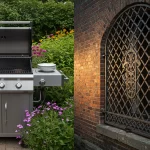
The Grill as a Cooking Method
Grilling isn’t just cooking—it’s an experience. At its core, grilling involves applying direct, radiant heat to food, typically from below, though some styles use heat from above or the side. This high-heat method cooks food quickly, creating a caramelized crust thanks to the Maillard reaction, a chemical process that occurs when proteins and sugars react at temperatures above 310°F (154°C) (source).
Key characteristics of grilling:
- Speed: Ideal for foods that cook fast, like burgers, veggies, and thin cuts of meat.
- Flavor: Open flames or smoldering charcoal infuse food with a smoky, charred taste.
- Versatility: Works for meats, seafood, vegetables, and fruits like peaches or pineapples.
Fun fact: Grilling is often confused with barbecuing, but they’re different. Barbecuing uses low, indirect heat over long periods, while grilling is all about high heat and quick results (source).
The Grill as a Cooking Device
A grill is also the physical appliance that makes this magic happen. Most grills feature a metal grate or gridiron placed over a heat source, which can be fueled by charcoal, gas (propane or natural), or electricity. Modern designs range from portable camping grills to massive outdoor stations with side burners and smoker boxes.
Key components of a grill:
- Cooking grate: Where the food sits. Cast iron or stainless steel grates retain heat well.
- Heat source: Charcoal, gas, or electric elements.
- Lid: Traps heat for more even cooking (essential for indirect grilling).
Regional terminology can get tricky. In the U.S., cooking with heat from above is called broiling, while the British use “grilling” for the same method (source).
Regional Variations: How the World Defines “Grill”
United States vs. United Kingdom
- U.S.: “Grilling” means cooking over direct heat from below. “Broiling” refers to overhead heat, usually in an oven.
- UK: The term “grill” covers both methods. A U.K. “grill” is functionally the same as a U.S. broiler (source).
Global Grilling Traditions
- Japan: Yakitori grills use binchō-tan charcoal for skewered meats.
- Argentina: Asado involves slow-grilling meats over wood-fired pits.
- South Africa: The braai is a social event centered around open-fire grilling.
Types of Grills: Which One Fires Up Your Passion?
1. Charcoal Grills
Fuel: Charcoal briquettes or lump charcoal.
Best for: Purists who crave smoky flavor and don’t mind a learning curve.
Pros:
- Unmatched smoky taste.
- Use high heat (up to 700°F) for perfect searing.
- Portable and affordable (e.g., classic Weber kettle).
Cons:
- Longer setup and cleanup.
- Temperature control requires practice.
Ideal for: Barbecue enthusiasts and weekend warriors.
2. Gas Grills
Fuel: Propane or natural gas.
Best for: Convenience-seekers and families.
Pros:
- Lights up instantly with a knob twist.
- Precise temperature control.
- Low cleanup (no ash).
Cons:
- Less smoky flavor than charcoal.
- Higher upfront cost.
Pro tip: Add a smoker box with wood chips to gas grills for extra flavor.
3. Electric Grills
Fuel: Electricity.
Best for: Apartment dwellers or indoor grilling.
Pros:
- Smoke-free and safe for balconies.
- Easy to use (plug and play).
Cons:
- Lacks authentic charred flavor.
- Limited portability (needs an outlet).
4. Flattop Grills (Planchas)
Fuel: Gas, charcoal, or electric.
Best for: Versatile cooking (think pancakes, stir-fries, and smash burgers).
Pros:
- Large, flat surface for cooking multiple items.
- Even heat distribution.
Cons:
- Less traditional “grill” experience.
Grill Comparison Table
| Type | Fuel | Best For | Heat Range | Flavor |
|---|---|---|---|---|
| Charcoal | Charcoal | Smoky flavor, searing | 200°F–700°F | High |
| Gas | Propane/Gas | Convenience, control | 200°F–600°F | Medium |
| Electric | Electricity | Indoor/urban use | 200°F–450°F | Low |
| Flattop | Any | Versatile cooking | 200°F–500°F | Customizable |
Choosing the Right Grill for Your Lifestyle
For Social Gatherers
A large gas grill with multiple burners lets you cook burgers, dogs, and veggies simultaneously. Bonus: Side shelves for prep space and a built-in thermometer for stress-free hosting.
For Sports Fans
Go portable! A compact charcoal grill like the Weber Smokey Joe is perfect for tailgating. Pair it with disposable trays for easy cleanup.
For Barbecue Enthusiasts
Invest in a kamado-style ceramic grill (e.g., Big Green Egg). It retains heat for hours, doubling as a smoker for brisket or ribs.
For Families
A 3-burner gas grill with a safety lock and durable grates balances ease and functionality. Look for models with a warranty, like those from Napoleon or Weber.
Pro Grilling Tips for Every Audience
- Preheat Like a Pro: Always let your grill heat up for 10–15 minutes. This prevents sticking and ensures even cooking.
- Oil the Grate, Not the Food: Brush oil onto the grates (not the food) to avoid flare-ups.
- Master the Zones: Create direct (high heat) and indirect (low heat) zones. Sear steaks over direct heat, then move to indirect to finish.
- Safe Temperatures: Use a meat thermometer. Chicken should hit 165°F, burgers 160°F (USDA guidelines).
- Rest Your Meat: Let steaks rest for 5–10 minutes post-grill to lock in juices.
Conclusion: Ignite Your Grilling Journey
From the smoky allure of charcoal to the convenience of gas, the grill is more than a tool—it’s a gateway to unforgettable moments. Whether you’re flipping burgers at a family reunion, searing brats at a tailgate, or experimenting with global flavors, understanding your grill’s capabilities unlocks endless possibilities.
Ready to fire it up? Share your favorite grilling stories or tag us in your BBQ masterpieces. And if you’re still grill-shopping, check out our top-rated picks here

